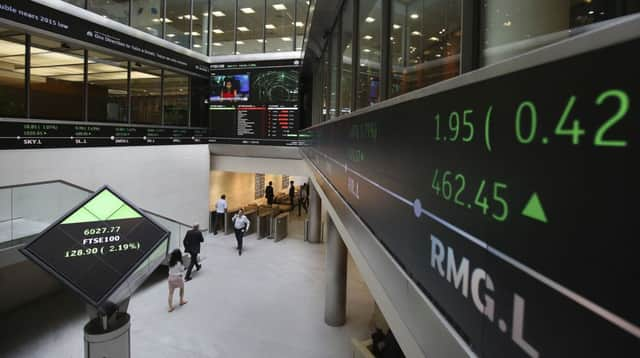Global markets see-saw reaction to Chinese turmoil


Early trading saw the index of the top 100 UK-listed companies slump more than 100 points to below 6,000, wiping more than £30 billion off their combined value.
Sentiment later recovered gradually to see it edge above its closing mark but it then fell back into the red, despite stocks in New York surging higher on the opening bell in Wall Street – after encouraging US factory data.
Advertisement
Hide AdAdvertisement
Hide AdWall Street then witnessed an afternoon surge which gave the stock market its best day in close to four years, as US stocks rebounded from a six-day slump, the benchmark Dow Jones industrial average surging more than 600 points, its third-biggest one-day rise ever .
London’s listed mining giants – which have been badly hit by the slowdown in China and its impact on commodity prices – were at the heart of the volatility, seeing both falls and climbs during the day.
The latest turbulence came after a 3.1 per cent rise in the FTSE 100 in the previous session, boosted by an interest rate cut from China. That had followed a ten-day run of declines for the index, its longest losing streak since 2003, including a 4.7 per cent fall on Monday that was the joint-worst one-day drop since the dark days of 2009.
The latest session in London saw an initial steep fall of around 130 points, or 2 per cent, following a Wall Street slump late the previous day and another fall overnight for China’s Shanghai Composite.
Connor Campbell, financial analyst at Spreadex, said European markets had been buoyed up by hints that the European Central Bank would be ready to inject more stimulus into the eurozone economy if needed.
But he added: “Such robust trading couldn’t last long, with losses beginning to widen once again after the post-US open dust settled.”
Yet the reading “might struggle to make itself heard if the markets have to endure another choppy Asian session”.
Global markets have been rocked in recent weeks by the slowdown in China, the world’s second biggest economy, and the depreciation of the yuan.
Advertisement
Hide AdAdvertisement
Hide AdChancellor George Osborne has said the volatility showed that “lots of risks” remained in the global economy and that Britain was “not immune to what goes on in the world”.
Recent falls have seen the FTSE 100 fall into “correction” territory, more than 10 per cent off its all-time closing high of 7,104 in April.
On Tuesday, China’s central bank cut its key lending rate by 0.25 percentage points to 4.6 per cent in a bid to calm stock markets after the past days’ turmoil.
The dramatic losses and volatility in China have shattered investor confidence and led to sharp falls in Asia and the US over the past few sessions. The interest rate cut was the fifth by the People’s Bank of China since November last year.
The move is aimed at boosting China’s growth long-term, rather than having an immediate impact on investors.
Given China’s central role in world trade, a slowdown in the world’s second-largest economy would be likely to reverberate around the globe, with a particularly negative impact on commodity prices, including oil and gas. A rate cut will make it cheaper for banks to borrow from the central bank and will in turn make it easier for businesses and private people to borrow money from those banks.
Yesterday, the Shanghai index fell 1.27 per cent to 2,927.29, after veering in and out of negative territory.